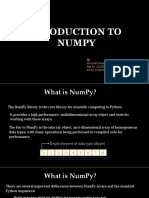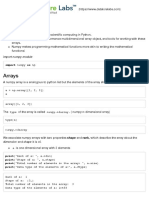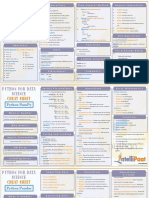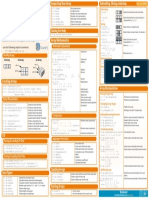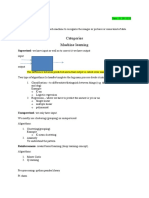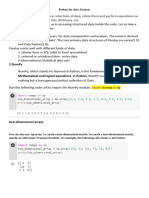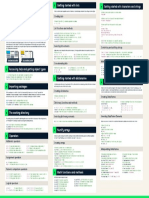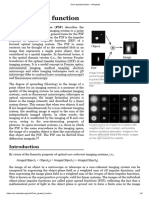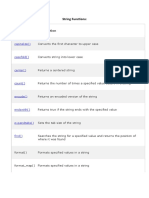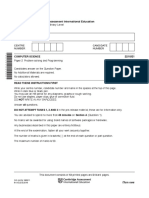Data structures in Python and
modules
Gianfranco Lombardo, Ph.D
gianfranco.lombardo@unipr.it
Dictionary
● Data structure for key-value items
○ my_dict = { “Alice” : “Boss”,
○ “George”: “Project manager”,
○ “Mario” : “Developer” }
● Also known as “ associative arrays” or map
● Unordered set of key / value pairs
○ Keys are unique as indices in lists and can be used to access the
associated value
○ Keys are usually string, but can be also int or any immutable type
2020 - Gianfranco Lombardo, MEng (gianfranco.lombardo@unipr.it)
Dictionary
Py
>>> tel = {} #Initialize an empy dict called tel
>>> tel["mario"] = "052-87653" #add “Mario” key with his value
>>> print(tel)
{'mario': '052-87653'}
>>> my_dict = {"George":"051-43235"} #initialize my_dict with one value
>>> my_dict["Mario"] = "052-87653" #add an item to my_dict
>>> print(my_dict)
{'George': '051-43235', 'Mario': '052-87653'}
2020 - Gianfranco Lombardo, MEng (gianfranco.lombardo@unipr.it)
Iterate over a dictionary
Py
my_dict = {"George":"051-43235", “Alice”: “053-74123”,”Bob”:”051-23619”}
for key in my_dict:
#remember that dictionaries are unordered!
if key==”George”:
print(“George number is “+str(my_dict[key]))
my_dict[“George”] = “3409823654” #change value
my_dict.pop(“Alice”) #remove Alice from the dictionary
2020 - Gianfranco Lombardo, MEng (gianfranco.lombardo@unipr.it)
Matrix
● A matrix is an ordered tables of elements
○ Example: Chessboard, Algebra matrices, datasets
● We can see as multidimensional lists!
● Basically a main list with inside other lists with the same number of elements
a = [ ['A', 'B', 'C', 'D'],
['E', 'F', 'G', 'H'],
['I', 'L', 'M', 'N'] ]
● To access an element we need two indices:
○ row y
○ column x
○ matrix[y][x]
2020 - Gianfranco Lombardo, MEng (gianfranco.lombardo@unipr.it)
Sum of columns in a matrix
Py
matrix = [[2, 4, 3, 8],
[9, 3, 2, 7],
[5, 6, 9, 1]]
rows = len(matrix) # get number of rows
cols = len(matrix[0]) # get number of columns
for x in range(cols):
total = 0
for y in range(rows):
val = matrix[y][x]
total += val
print("Column "+str(x)+ " sums to “+str(total))
2020 - Gianfranco Lombardo, MEng (gianfranco.lombardo@unipr.it)
Flatten matrix as a list
Py
matrix = [2, 4, 3, 8,
9, 3, 2, 7,
5, 6, 9, 1]
rows = 3 # Cannot be guessed from matrix alone
cols = len(matrix) // rows
for x in range(cols):
total = 0
for y in range(rows):
val = matrix[y * cols + x] # 2D -> 1D
total += val
print("Col #", x, "sums to", total)
2020 - Gianfranco Lombardo, MEng (gianfranco.lombardo@unipr.it)
Python external modules
● Sometimes we need functionalities and operations that are not directly
provided by Python
● Or we want to reuse some code already written by another developer
● In those cases we need to import a module in our code!
● Python is the most used language for Data science especially for the richness
of different modules
● Examples:
○ Math : for mathematical operations
○ Numpy for matrix and vectors
○ Pandas for data mining
○ Matplotlib for data visualization
○ Scikit-learn for Machine learning
○ Keras and Tensor-flow for Deep learning
2020 - Gianfranco Lombardo, MEng (gianfranco.lombardo@unipr.it)
Math module
import math
y = math.sin(math.pi / 4)
print(y) # √2 / 2
from math import sin, pi
print(sin(pi / 4))
from random import randint
die1 = randint(1, 6) # like rolling a die
die2 = randint(1, 6) # like rolling a die
2020 - Gianfranco Lombardo, MEng (gianfranco.lombardo@unipr.it)
How to install a module
● Most of the modules have to be installed
● PIP is the tool already installed with Python that permits to install new
modules!
● example: pip install “name of modules”
○ pip install numpy
2020 - Gianfranco Lombardo, MEng (gianfranco.lombardo@unipr.it)
NumPy
● Efficient library that provides multidimensional array and algorithms
● It is the base of most of the machine learning and data science libraries
● Implemented in Fortran, C, C++
● To use after installation:
○ import numpy as np
● Define a vector ( or array ) in numpy:
○ a = np.array([2, 3, 4])
2020 - Gianfranco Lombardo, MEng (gianfranco.lombardo@unipr.it)
Zeros, ones, ranges
>>> np.zeros(4)
array([0, 0, 0, 0])
>>> np.ones((2, 3), dtype=np.int16) # dtype can also be specified
array([[[1, 1, 1],
[1, 1, 1]], dtype=int16)
>>> np.empty((2, 3)) # uninitialized, output may vary
array([[3.73603959e-262, 6.02658058e-154, 6.55490914e-260],
[5.30498948e-313, 3.14673309e-307, 1.00000000e+000]])
>>> np.arange(10, 30, 5) # from 10, to 30, step 5
array([10, 15, 20, 25])
>>> np.linspace(0, 2, 5) # 5 numbers from 0 to 2
array([0, 0.5, 1, 1.5, 2])
2020 - Gianfranco Lombardo, MEng (gianfranco.lombardo@unipr.it)
Reshape and resize
>>> a = np.arange(12) # [0, 1, 2, 3, 4, 5, 6, 7, 8, 9, 10, 11]
>>> a = a.reshape(3, 4) # a new array
>>> a
array([[0, 1, 2, 3],
[4, 5, 6, 7],
[8, 9, 10, 11]])
>>> a.shape # Shape gets number of elements along each axes
(3, 4)
>>> a.resize(2, 6) # modifies the array itself
>>> a
array([[0, 1, 2, 3, 4, 5],
[6, 7, 8, 9, 10, 11]])
2020 - Gianfranco Lombardo, MEng (gianfranco.lombardo@unipr.it)
Shuffle and choice
>>> a = np.arange( 6)
>>> np.random.shuffle(a) # modifies the array itself
array([5, 3, 2, 4, 1, 0]])
>>> np.random.choice([ "A","B"]) #Choose randomly an element in a list
>>> “B”
>>>np.random.choice([ "one", "two"], (2, 3))
>>> array([[ 'two', 'one', 'one'],
['two', 'two', 'one']])
#Generate a matrix by choosing randomly elements in the list
2020 - Gianfranco Lombardo, MEng (gianfranco.lombardo@unipr.it)
Elementwise operations
● A new array holds the result
>>> a = np.array([20, 30, 40, 50])
>>> conditions= a < 35
array([True, True, False, False])
>>> b = np.arange(4)
>>> b_square = b ** 2
array([0, 1, 4, 9])
>>> c = a - b
array([20, 29, 38, 47])
2020 - Gianfranco Lombardo, MEng (gianfranco.lombardo@unipr.it)
Aggregate functions
>>> b = np.arange(12).reshape(3, 4)
>>> b
array([[0, 1, 2, 3],
[4, 5, 6, 7],
[8, 9, 10, 11]])
>>> b.sum() # guess also min and max
66
>>> b.sum(axis=1) # sum of each row
array([6, 22, 38])
>>> b / b.max(axis=0) # norm each column
array([[0., 0.11, 0.2, 0.27],
[0.5, 0.55, 0.6, 0.63],
[1., 1., 1., 1. ]])
2020 - Gianfranco Lombardo, MEng (gianfranco.lombardo@unipr.it)
Indexing and slicing
b = np.array([[0, 1, 2, 3],
[10, 11, 12, 13],
[20, 21, 22, 23]])
>>> b[2, 3]
23
>>> b[:, 1] # each row in the second column of b
array([1, 11, 21])
>>> b[1:3, 0:2]
array([[10, 11],
[20, 21]])
2020 - Gianfranco Lombardo, MEng (gianfranco.lombardo@unipr.it)
CSV files
● CSV files (Comma separated values) is one of the most common file format in
data science
○ It requires that the first line is an header where each field is separated
with a comma
○ The other lines are values separated by a comma
○ Basically, it represents always a table
○ Available also in Microsoft Excel
● It is possible read a CSV file with operators that with the Python open() by
splitting each line for commas or other ad-hoc modules are available like csv
or Pandas ( later in this lesson…)
2020 - Gianfranco Lombardo, MEng (gianfranco.lombardo@unipr.it)
CSV EXAMPLE
Name,Age,Job,City #Header
George,34,Waiter,Chicago
Alice,27,Developer,New York
Mario,57,Plumber, Rome
Lauren,42,Teacher,Detroit
Robert,29,Engineer,London
2020 - Gianfranco Lombardo, MEng (gianfranco.lombardo@unipr.it)
CSV module
import csv ###### without module
matrix = [] matrix = []
with open('people.csv', with open('people.csv', newline='')
newline='') as f: as f:
reader = csv.reader(f) reader = f.readlines()
for row in reader: for line in reader:
matrix.append(row) row =
print(matrix) line.replace("\r\n","").split(",")
matrix.append(row)
with open('people_2.csv', 'w', print(matrix)
newline='') as f:
writer = csv.writer(f)
for row in matrix: ………
writer.writerow(row)
2020 - Gianfranco Lombardo, MEng (gianfranco.lombardo@unipr.it)
Exercise:
● Ask to the user to add 10 people information:
○ Name
○ ID
○ Age
● Save these information in a dictionary where the key is always the ID and the
value is a list [name,age]
● Then ask again to add more information for these people by asking the ID and
add to each one:
○ Salary
○ Years of work
● Finally, export the entire dictionary into registry.csv file
○ header: Name,ID,Age,Salary,Years of work
2020 - Gianfranco Lombardo, MEng (gianfranco.lombardo@unipr.it)
Exercise
● Read the previous registry.csv
○ Skip the first row and save as a separate list called headers
○ Memorize the other rows in a matrix
○ Then ask to the user the name of a field:
■ Retrieve which column has to be considered from headers
■ Compute min and max for that column
2020 - Gianfranco Lombardo, MEng (gianfranco.lombardo@unipr.it)
Chessboard
● Generate a zero vector with dimension 64 as a pseudo matrix
○ Zero means black
○ One means white
● Iterate over the matrix with two “for” and put “1” if the column is pair ( c%2 ==
0)
● Transform the list as numpy array and then reshape as a 8x8 matrix
● Print the matrix
2020 - Gianfranco Lombardo, MEng (gianfranco.lombardo@unipr.it)



















